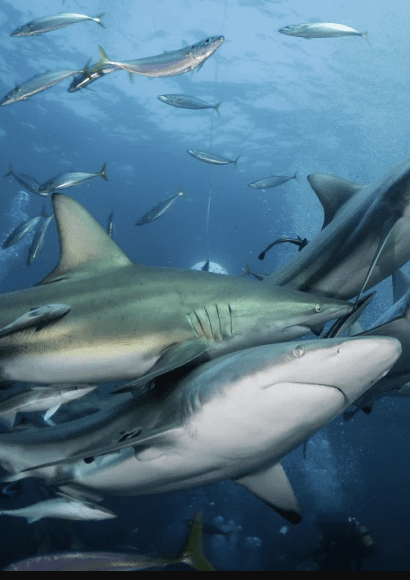
Sharks are fascinating creatures that have roamed the oceans for millions of years. These incredible animals are perfectly adapted to life in the open sea, where they play a crucial role in maintaining the balance of marine ecosystems. In this article, we’ll dive into the world of sharks, exploring their physical characteristics, hunting habits, and how they live in the vast, open ocean.
Sharks come in many shapes and sizes, from the tiny dwarf lantern shark to the enormous whale shark. Despite their fearsome reputation, most sharks are not dangerous to humans and are essential for the health of the oceans. By understanding more about their lives, we can appreciate these magnificent creatures and the important role they play in the underwater world.
Contents
Physical Characteristics of Sharks.🐟
Sharks are incredible creatures that have fascinated humans for centuries. In this section, we’ll explore the unique physical features that make them such efficient hunters in the open sea. Understanding these characteristics helps us appreciate their role in the ocean’s ecosystem and their amazing adaptations.
Streamlined Bodies.
Sharks have sleek, streamlined bodies that allow them to move quickly and efficiently through the water. This shape reduces water resistance, making them excellent swimmers. Their bodies are covered with tiny, tooth-like scales called dermal denticles, which further reduce drag and help them glide smoothly.
Cartilaginous Skeletons.
Unlike most fish, sharks have skeletons made of cartilage instead of bone. Cartilage is lighter and more flexible than bone, giving sharks greater agility and speed. This adaptation is particularly useful for their active lifestyle in the open sea.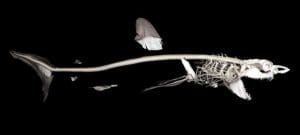
Powerful Senses.
Sharks are equipped with an array of powerful senses that make them formidable predators. Let’s take a closer look at these senses:
Exceptional Vision.
Sharks have excellent vision, even in low light conditions. Their eyes are adapted to see well in the deep, dark waters of the open sea. This helps them locate prey and navigate their environment effectively.
Acute Hearing.
Sharks can hear sounds from great distances. They are especially sensitive to low-frequency sounds, which helps them detect the movements of potential prey. This acute sense of hearing is crucial for hunting in the vast ocean.
Superior Smell.
One of the most remarkable senses of sharks is their sense of smell. They can detect a tiny amount of blood in the water from miles away. This ability makes them efficient hunters, capable of tracking injured or distressed prey with ease.
Electroreception.
Sharks possess a unique sense called electroreception. They have special organs called ampullae of Lorenzini that detect electrical fields produced by other animals. This sense is incredibly useful for locating prey hidden in the sand or navigating through murky waters.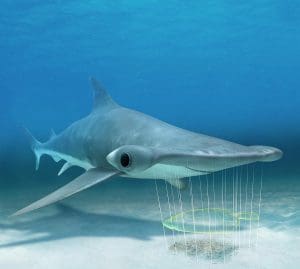
Variety in Size and Shape
Sharks come in a wide range of sizes and shapes, each adapted to their specific habitats and hunting styles. From the tiny dwarf lantern shark, which can fit in your hand, to the gigantic whale shark, the largest fish in the sea, sharks demonstrate an incredible diversity.
Adaptations for Hunting.
Sharks have evolved various adaptations that make them efficient predators. These include:
-
- Sharp Teeth: Sharks have multiple rows of sharp teeth that are constantly replaced throughout their lives. This ensures they always have a perfect set of teeth for catching and eating prey.
- Powerful Jaws: Their strong jaws can deliver a powerful bite, capable of capturing and consuming a wide variety of prey.
- Flexible Bodies: The flexibility of their bodies allows sharks to make quick, sharp turns, essential for chasing down fast-moving prey.
By understanding these physical characteristics, we can better appreciate the life of sharks in the open sea and the remarkable adaptations that have allowed them to thrive for millions of years.
Related Reading.
For more interesting marine topics, check out our article on 5 recipes with halibut fish. These delicious and easy recipes will make you love seafood even more!
Feeding Habits of Sharks.🐟
Sharks are some of the most efficient hunters in the ocean. Their feeding habits and strategies have evolved over millions of years, allowing them to thrive in the open sea. Understanding what and how they eat helps us appreciate the role they play in maintaining the balance of marine ecosystems. In this section, we’ll explore the diverse diets and hunting techniques of these fascinating creatures.
What Do Sharks Eat?
Sharks have a varied diet depending on their species, size, and habitat. Some sharks are specialized feeders, while others have a more general diet.
Common Prey Items.
-
- Fish: Many sharks, such as the great white shark, primarily eat fish. Their diet can include small schooling fish to larger fish like tuna.
- Squid and Octopus: These are favorite foods for species like the hammerhead shark.
- Crustaceans: Smaller sharks, like the smooth dogfish, often feed on crabs and lobsters.
- Marine Mammals: Larger sharks, such as the tiger shark, may hunt seals, dolphins, and even whales.
Unique Feeding Strategies.
Different shark species have developed unique strategies to catch their prey. These adaptations make them formidable hunters in their respective environments.
Ambush Predators.
Some sharks, like the wobbegong, use camouflage to blend in with the ocean floor. They lie in wait until an unsuspecting prey swims by, then strike with lightning speed.
Active Hunters.
Species like the great white shark are active hunters. They patrol vast areas of the ocean, using their keen senses to detect and chase down prey. Their speed and power make them incredibly effective.
Special Adaptations for Feeding.
Sharks have several physical adaptations that aid in their feeding.
Sharp Teeth.
- Rows of Teeth: Sharks have multiple rows of teeth that are constantly replaced. This ensures they always have sharp teeth ready for capturing prey.
- Variety in Teeth: Different species have different types of teeth adapted to their diet. For example, the tiger shark has serrated teeth for slicing through flesh, while the whale shark has tiny, filter-feeding teeth.
Powerful Jaws.
Sharks’ jaws are designed to deliver a strong bite. The muscles in their jaws are powerful, allowing them to clamp down on even the toughest prey. This is especially useful for species that hunt large animals or need to crush shells of crustaceans.
Role in the Ecosystem.
Sharks are apex predators, meaning they are at the top of the food chain. Their feeding habits help control the population of their prey, which maintains the balance in marine ecosystems. Without sharks, the ocean’s food web would be disrupted, leading to negative effects on marine life.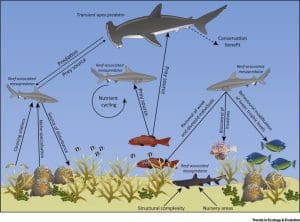
Conservation and Awareness.
Despite their fearsome reputation, many shark species are threatened by overfishing and habitat destruction. It’s important to raise awareness about their crucial role in the ocean and promote conservation efforts.
Reproduction and Life Cycle.🐟
Sharks have fascinating and diverse methods of reproduction, which vary greatly among species. Understanding their reproductive strategies helps us appreciate their adaptability and the challenges they face in the wild. This section will explore the different reproductive methods of sharks, their life cycles, and the importance of conservation.
Reproductive Methods.
Sharks reproduce in three primary ways: oviparity, viviparity, and ovoviviparity. Each method is unique and has evolved to suit different environments and lifestyles.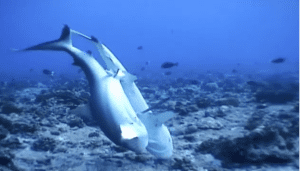
Oviparous Sharks.
Some sharks are oviparous, meaning they lay eggs. These eggs are often encased in protective cases known as “mermaid’s purses.”
- Species Examples: The horn shark and the swellshark are both oviparous.
- Egg Cases: These cases are usually attached to underwater structures like seaweed or coral to keep them safe from predators.
Viviparous Sharks.
Viviparous sharks give birth to live young. The embryos develop inside the mother’s body and receive nutrients through a placenta-like structure, similar to mammals.
- Species Examples: The great white shark and the hammerhead shark are viviparous.
- Live Births: This method allows the young to be more developed and capable of surviving on their own immediately after birth.
Ovoviviparous Sharks.
Ovoviviparous sharks have a combination of both methods. They produce eggs, but the eggs hatch inside the mother’s body. The young are born live.
- Species Examples: The whale shark and the tiger shark use this method.
- Protection: This method provides additional protection for the embryos, increasing their chances of survival.
Life Cycle Stages.
The life cycle of sharks includes several stages, each crucial for their development and survival.
Embryonic Stage.
The embryonic stage varies depending on the reproductive method. For oviparous sharks, the embryos develop inside the egg cases. For viviparous and ovoviviparous sharks, the embryos develop inside the mother.
- Duration: The length of this stage can vary from a few months to over a year, depending on the species.
Juvenile Stage.
Once born or hatched, young sharks are known as pups. They are independent from birth and must fend for themselves.
- Habitat: Many juvenile sharks stay in shallow waters or nursery areas to avoid predators.
- Growth: This stage involves rapid growth as the young sharks learn to hunt and survive.
Adult Stage.
As sharks reach maturity, they move to different habitats depending on their species and size. They begin to reproduce, continuing the cycle.
- Maturity Age: The age at which sharks reach maturity varies greatly. Some species mature within a few years, while others, like the great white shark, take much longer.
Importance of Conservation.
Shark populations face numerous threats, including overfishing, habitat destruction, and climate change. Understanding their reproductive strategies and life cycles is crucial for developing effective conservation measures.
- Protection Measures: Marine protected areas and fishing regulations help safeguard shark populations.
- Awareness: Educating the public about the importance of sharks in marine ecosystems is key to their conservation.
Related Reading.
For more fascinating insights into marine life and ancient fishing practices, check out our article on The oldest fishing tools. Discover how humans have been interacting with the ocean for thousands of years.
Popular Questions.🐟
How long can a shark live?
Sharks can live for many years, with some species, like the Greenland shark, living up to 400 years. Longevity varies significantly among species, with many sharks living between 20 and 30 years on average.
What do sharks eat?
A shark’s diet depends on the species. Some feed on plankton (like the whale shark), while others hunt fish, squid, and marine mammals. Sharks are known for their adaptability and can change their diet based on prey availability.
Do sharks attack humans?
Although sharks have a reputation for being dangerous to humans, attacks are rare. Most sharks do not see humans as prey. Attacks that do occur are usually the result of the shark’s curiosity or mistaken identity.


